Text
Brachiosaurus

Brachiosaurus is a sauropod from the Late Jurassic of North America. Unlike most sauropods, it had longer forelimbs than hindlimbs, giving it its name. This resulted in a steeply inclined posture, and a proportionally shorter tail. The nasal openings were large and located on the top of the skull, which originally caused paleontologists to assume their nostrils were likewise on top of the head. More recent research suggests the fleshy nostrils would have been in a more forward position, toward the front of the snout. Brachiosaurus is estimated to have been about 20 m long, weighing up to 50 t. It was likely a high browser, consuming vegetation as high as 9 m off the ground.
74 notes
·
View notes
Text
Fujianvenator
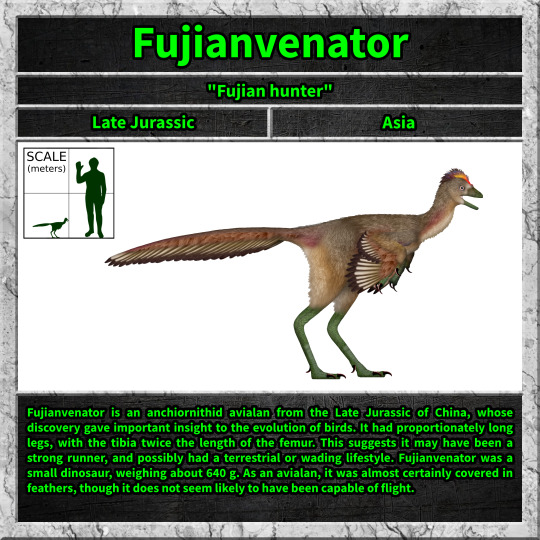
Fujianvenator is an anchiornithid avialan from the Late Jurassic of China, whose discovery gave important insight to the evolution of birds. It had proportionately long legs, with the tibia twice the length of the femur. This suggests it may have been a strong runner, and possibly had a terrestrial or wading lifestyle. Fujianvenator was a small dinosaur, weighing about 640 g. As an avialan, it was almost certainly covered in feathers, though it does not seem likely to have been capable of flight.
82 notes
·
View notes
Text
Acrocanthosaurus

Acrocanthosaurus is a carcharodontosaurid dinosaur from the Early Cretaceous of what is now North America. Large theropod footprints discovered in Texas are theorized to have been made by Acrocanthosaurus. It had a long narrow skull, with low ridges rising from the nasal bones, running along each side of the snout from the back toward the eye. Acrocanthosaurus is best known for the tall neural spines on the vertebrae down the neck, back, and upper tail. These spines likely supported a ridge of muscle down its back. It was one of the largest theropods, reaching around 11 m in length and weighing up to 7 t.
48 notes
·
View notes
Text
Utahceratops
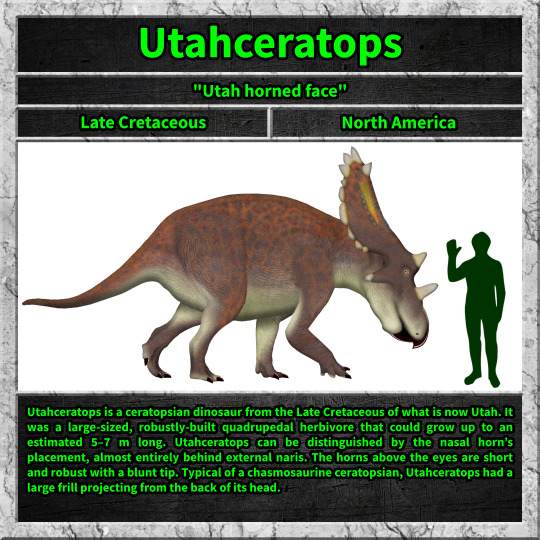
Utahceratops is a ceratopsian dinosaur from the Late Cretaceous of what is now Utah. It was a large-sized, robustly-built quadrupedal herbivore that could grow up to an estimated 5–7 m long. Utahceratops can be distinguished by the nasal horn’s placement, almost entirely behind external naris. The horns above the eyes are short and robust with a blunt tip. Typical of a chasmosaurine ceratopsian, Utahceratops had a large frill projecting from the back of its head.
57 notes
·
View notes
Text
Yutyrannus

Yutyrannus is the largest dinosaur discovered with direct evidence of feathers. It is a large basal tyrannosauroid, growing to about 9 m in length, and weighing around 1.5 t. Yutyrannus is known from three nearly complete individuals: an adult, subadult, and a juvenile. Because they were found together, it is theorized that they may have hunted in packs. Adults sported a high midline crest on the snout, as well as one above each eye. Unlike more derived tyrannosaurs, Yutyrannus had long forearms with three fingers on each hand. Feathers in the fossil specimens are present on various parts of the bodies of all three individuals, implying total coverage.
127 notes
·
View notes
Text
Megapnosaurus
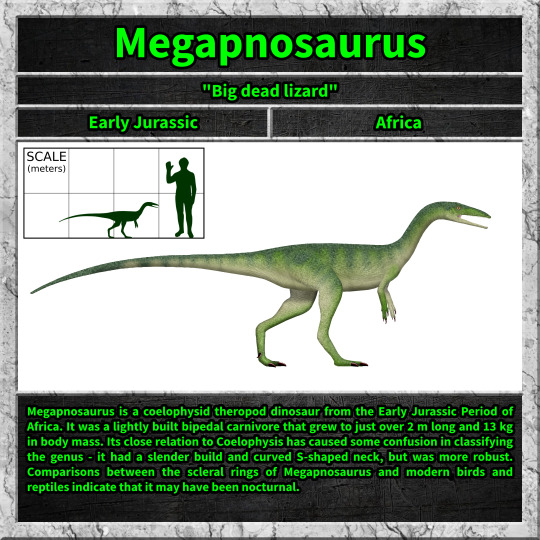
Megapnosaurus is a coelophysid theropod dinosaur from the Early Jurassic Period of Africa. It was a lightly built bipedal carnivore that grew to just over 2 m long and 13 kg in body mass. Its close relation to Coelophysis has caused some confusion in classifying the genus - it had a slender build and curved S-shaped neck, but was more robust. Comparisons between the scleral rings of Megapnosaurus and modern birds and reptiles indicate that it may have been nocturnal.
68 notes
·
View notes
Text
Aardonyx

Aardonyx is a basal sauropodomorph with many intermediate features between prosauropods and sauropods. It grew to about 6 m in length, and was facultatively bipedal. This means that it would normally walk on two legs, but could move on all fours as well. Its jaws also bear transitional features. They are more narrow than more derived sauropods, but seem to indicate sauropod-like reduced cheeks. This unusual combination of features suggest feeding behavior transitioning toward the bulk-browsing common in later sauropods.
79 notes
·
View notes
Text
Jaculinykus
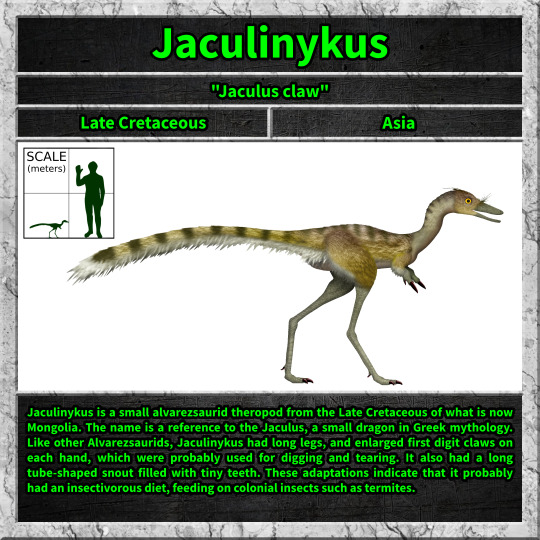
Jaculinykus is a small alvarezsaurid theropod from the Late Cretaceous of what is now Mongolia. The name is a reference to the Jaculus, a small dragon in Greek mythology. Like other Alvarezsaurids, Jaculinykus had long legs, and enlarged first digit claws on each hand, which were probably used for digging and tearing. It also had a long tube-shaped snout filled with tiny teeth. These adaptations indicate that it probably had an insectivorous diet, feeding on colonial insects such as termites.
78 notes
·
View notes
Text
Zuul
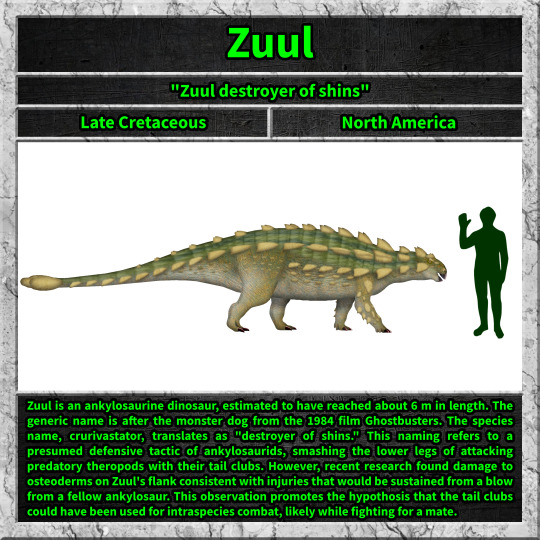
Zuul is an ankylosaurine dinosaur, estimated to have reached about 6 m in length. The generic name is after the monster dog from the 1984 film Ghostbusters. The species name, crurivastator, translates as "destroyer of shins." This naming refers to a presumed defensive tactic of ankylosaurids, smashing the lower legs of attacking predatory theropods with their tail clubs. However, recent research found damage to osteoderms on Zuul's flank consistent with injuries that would be sustained from a blow from a fellow ankylosaur. This observation promotes the hypothosis that the tail clubs could have been used for intraspecies combat, likely while fighting for a mate.
127 notes
·
View notes
Text
Concavenator
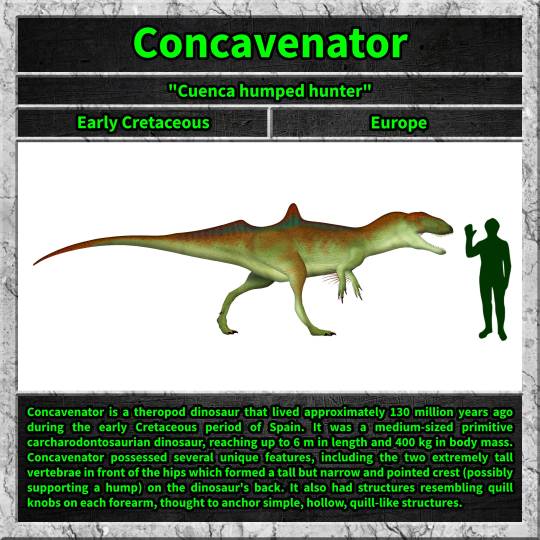
Concavenator is a theropod dinosaur that lived approximately 130 million years ago during the early Cretaceous period of Spain. It was a medium-sized primitive carcharodontosaurian dinosaur, reaching up to 6 m in length and 400 kg in body mass. Concavenator possessed several unique features, including the two extremely tall vertebrae in front of the hips which formed a tall but narrow and pointed crest (possibly supporting a hump) on the dinosaur's back. It also had structures resembling quill knobs on each forearm, thought to anchor simple, hollow, quill-like structures.
88 notes
·
View notes
Text
Brontosaurus
Check out the first original Unexpected Dino Lesson video about Brontosaurus!
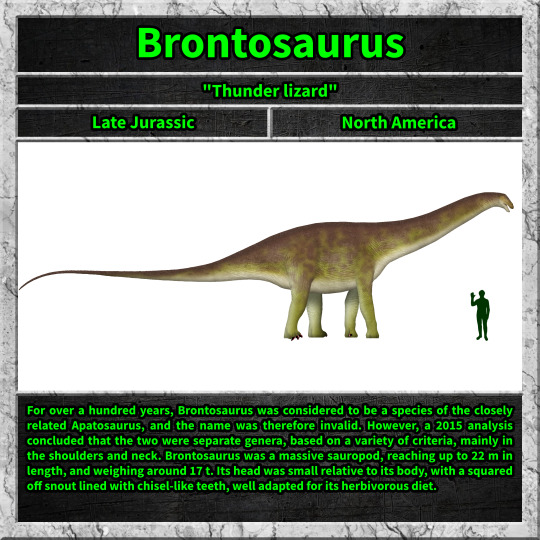
For over a hundred years, Brontosaurus was considered to be a species of the closely related Apatosaurus, and the name was therefore invalid. However, a 2015 analysis concluded that the two were separate genera, based on a variety of criteria, mainly in the shoulders and neck. Brontosaurus was a massive sauropod, reaching up to 22 m in length, and weighing around 17 t. Its head was small relative to its body, with a squared off snout lined with chisel-like teeth, well adapted for its herbivorous diet.
96 notes
·
View notes
Text
Hypsilophodon

Hypsilophodon is a basal neornithischian dinosaur from the Early Cretaceous period of England. It has traditionally been considered an early member of the group Ornithopoda, but recent research has put this into question. It was a small, agile bipedal animal with an herbivorous or possibly omnivorous diet, measuring up to 2 m long and weighing 20 kg. It had a pointed head equipped with a sharp beak used to bite off plant material, as well as five pointed triangular teeth in the front of the upper jaw.
61 notes
·
View notes
Text
Lanzhousaurus

Lanzhousaurus is an ornithopod dinosaur that lived in what is now China during the Early Cretaceous. It has been estimated to be about 10 m in length and 6 t in weight. The teeth that have been preserved in the meter-long lower jaw of Lanzhousaurus have been described as “astonishingly huge", and at 14 centimeters in length each, are among the largest of any herbivorous creature ever. The teeth indicate it was a styracosternan iguanodont, and the tooth enamel of this dinosaur grew very rapidly.
72 notes
·
View notes
Text
Alxasaurus

Alxasaurus is a therizinosauroid theropod dinosaur from the Early Cretaceous of China. Several specimens are known and they vary in size, but its maximum adult length is estimated up to 4 m and mass up to 400 kg. Alxasaurus is among the earliest known members of the Therizinosauroidea, but it already possessed the body shape, including the long neck, short tail, and relatively large claws, of later therizinosauroids. Like other members of this group, it was a bipedal herbivore with a large gut to process plant material.
85 notes
·
View notes
Text
Dacentrurus

Dacentrurus is a stegosaurian dinosaur from the Late Jurassic to Early Cretaceous, discovered in what is now England. Dacentrurus was one of the largest stegosaurs, with some specimens estimated to reach up to 9 m in length, and weighing around 5 t. Though finds of this animal have been limited and much of its appearance is uncertain, it was a heavily built quadrupedal herbivore with plates and spikes along its back.
86 notes
·
View notes
Text
Sauroposeidon

Sauroposeidon is a titanosaurian sauropod dinosaur known from several incomplete specimens including a bone bed and fossilized trackways that have been found in the U.S. states of Oklahoma, Wyoming, and Texas. The vertebrae are extremely elongated, with the largest one having an overall length of 1.4 m, making it the longest sauropod neck vertebra on record. Sauroposeidon was probably able to raise its head up to 18 m above the ground, and it is estimated around 30 m in total length. The mass of Sauroposeidon is estimated at 40–60 t.
111 notes
·
View notes
Text
Citipati

Citipati is an oviraptorid dinosaur that lived in Asia during the Late Cretaceous period. It was among the largest oviraptorids, estimated to have been around 2.5 m in length, and weighing about 80 kg. Its skull was short, and had a characteristic crest formed by the premaxilla and nasal bones. Both upper and lower jaws were toothless and developed a horny beak. Citipati is one of the best-known oviraptorids thanks to a number of well-preserved specimens, including individuals found in brooding positions atop nests of eggs. These nesting specimens have helped to solidify the link between non-avian dinosaurs and birds.
107 notes
·
View notes